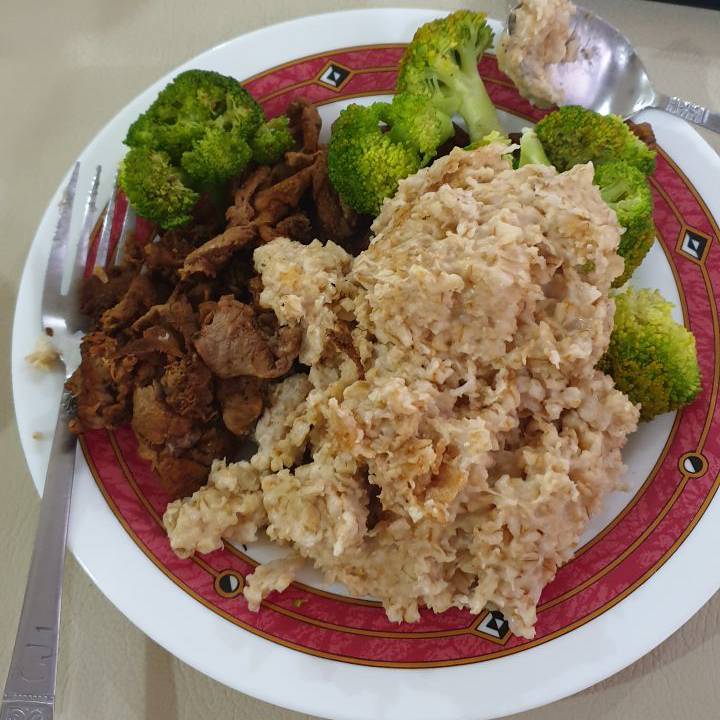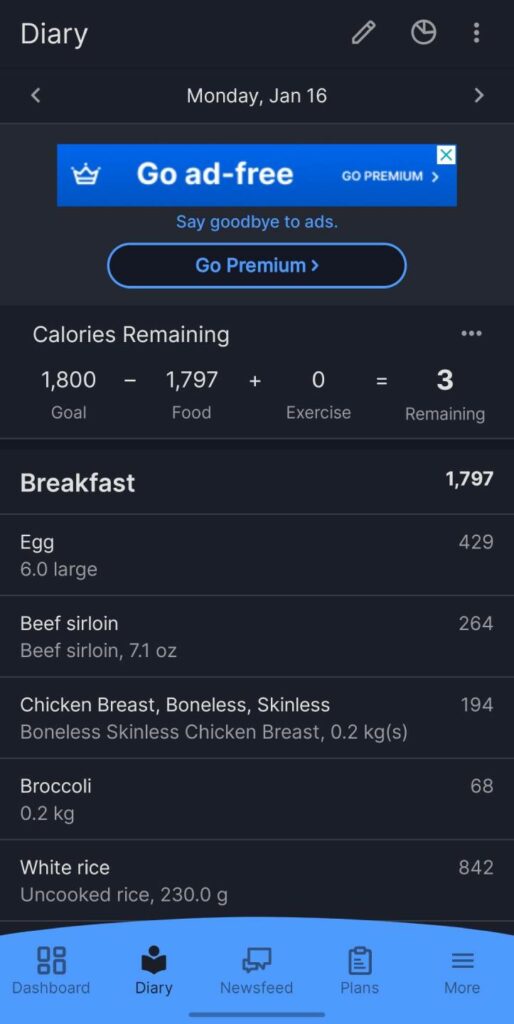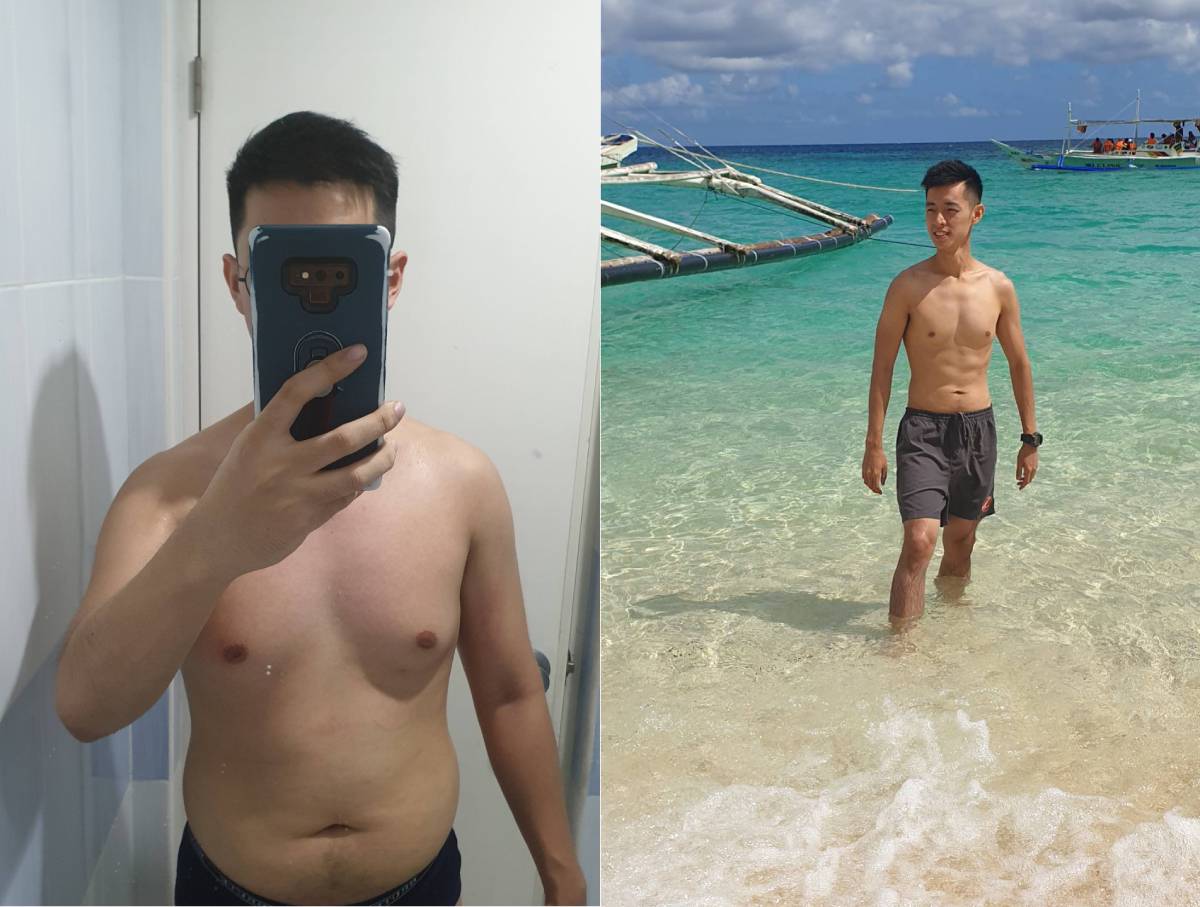New Year’s resolutions are always popular in the New Year, because the New Year brings about the most excitement in self-improvement & reinventing ourselves. It’s not uncommon to hear others set:
- an income goal
- getting organized
- learning a new skill or hobby
- budgeting goals
- breaking old habits or addictions
- travel goals
Apart from this, one of the most popular New Year’s resolutions I always hear of is when people make fitness goals for the year.
You may be seeing me a little more often posting in my Facebook & Instagram stories about hitting the gym & showcasing my physique, but not everyone knows I wasn’t always that way. I used to gain a lot of weight during the lockdowns during the COVID-19 pandemic due to overeating. Thankfully, I also used the pandemic to experiment like a madman when it came to losing weight.
And my experimentation wasn’t in vain.
What you’re about to read is the process I have honed in called the “Calculated Diet”. It’s the diet I have used to systematically & predictably lose 12 kg, down to the calorie.
Mindset
Now in a blog post about losing weight in general, why dedicate a section about mindset? Isn’t it just about diet & gym tips, tricks, & hacks? Unfortunately, that’s not the only thing that’s important when it comes to sticking to a weight loss plan sustainably for the long haul.
In the past few years, I have gone on & off the gym with little to no success. In the last 2 years, I FINALLY made massive progress into my fitness. What changed? One of the biggest things I’ve now incorporated into my fitness routine is mindset. It’s what kept me going while I didn’t see results right away, and it’s what will keep me into this routine long after I have achieved my dream physique.
What’s At Stake?
According to a 1991 study by the journal of “Organizational Behavior and Human Decision Processes“, humans were willing to take more risks to avoid a loss than to achieve a gain of equal value. Knowing that, why don’t we leverage that cognitive bias to our favor?
So first, you need to define what’s at stake when you don’t achieve your dream physique. Imagine 2 future selves you have: one where you got into your dream body & one that didn’t. What were some of the benefits the fit one gained? List them down. Then take yourself back to your current self. What were these benefits you just lost? Notice how I mentioned lost. We want to make you really feel bad about missing out on these things that come with having your dream physique.
Personally? My reason was simple & shallow. When I started, I wanted all the girls to look at me & think I’m attractive when I go take off my shirt. Girls never noticed me back in high school & college, so it was the biggest chip in my shoulder I can leverage in the beginning when I needed it the most.
Yours can take on different forms. Aside from being more attracrive to the opposite sex (which is very valid, don’t let anyone tell you it’s “shallow”), here are some I can think right off my mind:
- Get over a breakup & find a better partner
- Live long enough to enjoy your wealth & the fruits of your labor
- Live long enough to see your great grandchildren grow & play
- Become a good example to your kids when it comes to health & wellness
- Revive your marriage’s dead bedroom
- Close more fitness coaching deals as a fitness trainer
- Get more modeling jobs
- Get more job offers (being more attractive has been proven to get more jobs)
- Close more deals (also proven)
- … and many more
What matters is that it has to be true to you. Don’t BS yourself to thinking to yourself that the reason you want to get in shape is a noble one, when in reality it’s a lot simpler & shallow like mine.
Really imagine yourself losing that main benefit your fit future self had because you didn’t follow through. Some people say it’s toxic; I personally think we’re leveraging a basic cognitive bias to our favor.
What Does Your Dream Body Look Like?
Next, define what your dream body look like. Do you want to be super muscular? Or do you just want to lose weight & be slim? Print a picture of it to remind yourself what you will look like after you have achieved your goal.
Personally, another reason I started getting into fitness was because I had a friend who has my ideal physique (no homo). This was what he looked like.

And I became cheeky about it & placed my face above the body to imagine myself already having it.

Set the Intention
This sounds VERY simple, but surprisingly, I’m just shocked no one who sets goals even sets the intention to achieve the goal in the 1st place. What do I mean by setting the intention? Even as simple as deciding to yourself that you will go for your desired physique silently is enough.
One of the sneaking suspicions I had why people don’t even set intentions is that they hate failing, let alone failing themselves. However, remember that in a long enough time frame as long as you keep pushing yourself to your goal consistently, you will reach it eventually. There’s no question about it.
Change Your Identity
This is something I learned from James Clear’s “Atomic Habits”. He mentioned that “True habit change is really identity change.”
True habit change is really identity change.
James Clear from Atomic Habits
Because you can’t really stick to the gym if you think you’re “an unhealthy person making a change for this year by going to the gym even if I don’t like it”, can’t you?
You need to have a deep identity change by thinking you’re “a healthy person currently taking on the challenge of transforming this unhealthy body to a healthy one”. THINK what a healthy person does in your shoes. Also BRAINWASH yourself to enjoy things a healthy person enjoys. Insert in your DNA the identity of a healthy person.
Envision That It’s Already Done
Finally, envision that it’s already done. This sounds very woo-woo, but this has also helped me get over the initial stages when it’s still too early to see results, despite gasping for air after my initial gym sessions.
Envision in your mind you’re already in your dream body. Wake up, & see that you’re already in your dream body. Walk into the gym with your dream body in your mind. Go to sleep with your dream body in your mind. As long as you are consistently putting in the effort, you’ll get there, and tell yourself, “It is done. Time just has to catch up.”
The Diet
There’s a very good chance you jumped in here right away & get to the main point by skipping the mindset section. If that’s you I highly recommend you turn back & read the mindset section first because if you don’t, you risk having this article become another blog post you read & not take action on, wasting another year in the same habits & the same body as last year. Would you even want that?
I noticed in my journey that mindset is one of the most important components I have incorporated in my plan that made my journey to losing 12 kg a success, even on top of the diet I’d be showing you in a bit. So this is your last chance to read about my mindset part of this article; otherwise, go on, read the “tactical” parts of this article, & risk becoming another person who just reads this & doesn’t take action.
Othewise if you came from the mindset section, welcome! It’s now time to dive in to the exact diet & workout plan I have used to help me lose 12 kg systematically & predictably, down to the single kg. Let’s hop on to the dead simple diet I have taken to shave body fat.
Setting the Initial Parameters
The legendary management consultant Peter Drucker famously said, “What gets measured gets improved.”
What gets measured gets improved
Peter Drucker
While that is true for business, it is even more true for health & fitness. I don’t care what any other fitness trainer tells you about losing weight; if you’re serous about losing any weight, you should be measuring what you eat.
First step: download MyFitnessPal in the App Store or Google Play. Then input EVERYTHING you eat in it.
Next, we will need to set some baseline parameters to kickstart how we will conduct our diet. Using this TDEE calculator, I will discover what’s the daily calories I need to intake daily to maintain my current weight. I am:
- Sex: Male
- Height: 171 cm
- Weight: 67 kg (started here, currently at 55 kg as I write)
- Activity: Sedentary (where I started)
Based on the parameters above, the calculator said that I needed to eat 1,931 calories/ day to maintain my weight. Good. We’re getting somewhere.
Here’s the dead simple principle when it comes to losing weight: when you eat less than you burn everyday, you are guaranteed to lose weight. It’s pretty funny looking at the weight loss market & seeing all these offers showing kooky methods to do the same simple thing because most people can’t accept that it can’t be THAT simple.
Knowing that we should eat less than what we burn daily, we will be setting our daily calorie intake by 1800 calories. Let’s move to our diet.
The Meal Plan

When you see my diet, most of you’d be so shocked that you won’t even take action just from seeing it. Here it is:
- 6 eggs
- 200 g beef
- 200 g chicken
- 200 g broccoli
- 230 g of white rice or rolled oats
That’s it. That’s what I eat day in & day out. What’s more important, though, is that you track the daily calories you take daily, which we are about to get to.
Here’s what that looks like for me:

When I say everything, I mean everything. Using cooking oil? That’s 100 calories.
Snacked a bit? Also calories.
This is where you should start learning to look at nutritional facts for every piece of food you eat. The calories are listed there for the specific serving size.
How to Measure Food
The next question would be: how would we measure food? Will we weigh them cooked or raw?
The answer? Raw.
When you weigh cooked, there’s way too much variables in play. Maybe you cooked it on oil & don’t know how much was absorbed in it. Maybe for the rice or oats, there’s more water inside per piece that it affects the weight.
When you weigh raw, you isolate all variables and KNOW the exact weight of the food you are measuring to a T. We are just doubly making sure about our measurements here. Of course, choose raw in MyFitnessPal if that’s the case.
Personally, I use this mechanical kitchen scale. However, I’d actually recommend going with a digital kitchen scale instead because reading from a digital display is so much easier.
How to Lose Weight or Gain Muscle With This Meal Plan
Here is how to lose weight or gain muscle with this exact diet.
With what I have laid out here, it is most important to maintain a good-high level of protein in what you eat. Why? 2 reasons:
- Protein helps build/ maintain muscle
- Protein also helps keep you full longer than regular carbs or any other food can
A good level I’m aiming for here is ~150 g of protein, and our amount of chicken breast & beef in the diet should cover that very nicely.
If you want to lose weight (or “cut”), what you should do is:
- Make sure you get in the habit of eating your set calories for the day. For me, it was 1800. Set your routine & habits to make sure you get this right daily. I recommend you do this for 2 weeks – 1 month straight just to get the hang of cooking your food right & sticking to the habit.
- Weigh yourself everyday for a week & take note if you are losing weight.
- If you are losing weight, don’t change your diet. If you aren’t, start dropping 100 cals/ day in your diet in the start of the upcoming week. It’s important we drop slowly by 100 cals & not do this too suddenly. The easiest way to decrease your cals is to just decrease the amount of rice/ rolled oats you eat per day. Simple!
- While doing this, hit the gym with the routine below to make sure you aren’t losing muscle mass while dropping weight. Most of the time, you won’t be able to hit heavier weights progressively because we are in a calorie deficit, so we don’t have much fuel to go heavier & heavier. A common problem people losing weight encounter is that they also lose muscle mass while cutting, so this gym step prevents that.
- Repeat steps 2-4 until you hit 1300 cals.
Just from these steps alone, I was able to lose 12 kg predictably! That’s basically it. If you can just follow these 5 steps, you can lose weight at will.
By now, you are at 1300 cals, which is dangerously low for your whole body system to stay in. We need to get it back to its regular calorie consumption level to prevent ourselves from starving too much. Otherwise, you will experience some negative effects like loss of libido (not fun) if you stay here too long. Luckily, if you want to gain muscle mass, we’re now about to do that, too!
When you want to gain muscle mass (or “bulk”), what you should do is:
- By now you should be consuming pretty low calories. In my case, it’s 1300 cals/ day, and you should be plateauing in losing weight.
- Weigh yourself everyday for a week & take note if you are gaining weight.
- If you aren’t gaining weight, raise your daily cal intake for the week by 100-200 daily. If you are gaining weight, keep your daily cal intake the same until you plateau. Again, easiest way to add daily cal intake is to increase rice/ rolled oats consumption.
- Keep hitting the gym while you’re increasing your cal intake. One thing you’ll notice is that when you go back to your daily cal intake before you reached this point, you’d still be losing weight! It’s because you’ve also incorporated the gym to your routine.
- Repeat steps 2-4 until you get to 2500 cals.
Currently, I’m at 1800 cals again at this stage, but I’ll update this when I reach 2500 & really be making serious muscle.
This is the stage where we aim to eat more than usual, but this time it’s different because we are hitting the gym already. When we eat more & we are constantly breaking our muscle fibers all the time in the gym, our food now goes into our muscles to help them recover with energy & rebuild them as stronger & bigger, whereas last time it had nowhere to go, so it was just stores as “fat”.
Since we’ve been mentioning a lot about weighing…
Weighing Yourself Everyday
One of the most recommended tasks to add to your routine when you’re looking to lose weight is to weigh yourself daily.
There has been a study done that proved that participants who weighed themselves everyday lost a lot more weight than those who weighed most days of the week (think ~5 days/ week), and everyone in the study didn’t change any diet strategies, caloric intake, or caloric expenditure.
The explanation given in the study for this was that people who weighed themselves daily adopted weight control behaviors a lot more than those who weighed most of the week.
One thing most people dread when embarking on losing weight is weighing themselves to check their progress. The reason most people dread this is because the scale is brutally honest: if you did your meals correctly, you should see your scale in the same weight or slightly lower. Otherwise, it meant you may have overate.
So my recommendation is to weigh yourself daily, and don’t overcomplicate the weighing scale you’ll buy. I even recommend you buy a simple one, such as this digital bathroom weighing scale. If you’re pressed for your budget, you can also grab this cheaper mechanical bathroom weighing scale.
Key point: DO NOT OVERCOMPLICATE THIS STEP. Buy the scale, then weigh yourself daily in the morning, after you wake up & use the bathroom & before eating or drinking anything. If you can’t do this daily, do it weekly for a start & slowly transition to daily.
The Workout
The workout is very simple. You wouldn’t believe I lost 12 kg with this in tandem with my diet. I follow a simple structure:
Monday
- Squats. 5 sets of 5 reps
- Standing overhead press: 5 sets of 5 reps
- Standing side lateral raise: 4 sets of 12 reps
- Bent Lateral Raise: 4 sets of 12 reps
- Cardio: 15 – 20 mins.
Tuesday
- Dead Lifts: 4 sets of 8 reps
- Incline Bench Press: 4 sets of 8 – 10 reps
- Dips: 4 sets of 8 – 10 reps
- Lat Pull Downs Machine: 4 sets of 12 – 15 reps
- Dumbell Flys: 4 sets of 12 – 15 reps
Wednesday
- Close Grip Bench Press: 4 sets of 8-10 reps
- Bicep Curls With The Bar: 4 sets of 8 – 10 reps
- Skull Crushers: 4 sets of 8 – 10 reps
- Seated hammer curls superset with hammer skull crushers using dumbells: 4 sets of 12 reps
- Cardio: 15-20 mins.
Thursday
- Lat Pulldowns: 5 sets of 5 (aiming to do Chin-ups when the strength builds up)
- Incline Bench Press: 4 sets of 8 – 10 reps
- Bent Over Rows: 4 sets of 8 – 10 reps
- Dips: 4 sets of 8 – 10 reps
- Cardio: 15-20 mins.
Friday
- Front Squats: 4 sets of 8-10 reps
- Standing Overhead Press: 4 sets of 8 reps
- Side lateral dumbbell raise: 4 sets of 12 – 15 reps
- Bent over lateral raise: 4 sets of 12 – 15 reps
- Cardio: 15-20 mins.
NOTE: I don’t follow this super strictly. I used to go to the gym 5x/ week, but during COVID-19 lockdowns, there was a time gym was limited in contact. So I went there 3x/ week, which is the schedule I still stick to sustainably.
So if I go there 3x/ week, I just go through the workouts of Monday > Tuesday > Wednesday for the week, then next week would be Thursday > Friday > Monday.
Maybe it’s not optimal, but the important thing is consistency.
Optimizations
After doing this for around 2 years already, I would also recommend some tips & tricks to newbies if they want to embark on the same journey as I am, which can speed up their progress.
Use this instead of cooking oil
Cooking oil adds an extra 100 cals/ tsp. If you are now highly conscious of the daily calories you take & hear the ones prepping your meal is using cooking oil, yikes.

Thankfully, there’s a cal free substitute for that. I use this non-stick cooking spray when cooking now.
The Cardio Workout That Burns the Most Cals Fast
I used to use the treadmill for my cardio, & a quick search says that jogging usually takes 145 cals/ 15 mins. Of course, it depends on how hard you run for those 15 mins.

Me personally? I discovered that jumping rope burns more cals per 15 mins. It has been shows that jumping rope can burn ~200 – 300 cals/ 15 mins. I use these jump ropes personally.
Tracking Your Progress
I highly recommend tracking your overall progress in the long run in some shape or form. The reason being that it’s so easy to get lost deep in the details when you sometimes need to zoom out & see your overall progress.
Maybe you’ve been stuck in a plateau & feel bad about it? But you may be forgetting that you may have lost a lot of weight compared to when you were starting.
I recommend tracking this even in a scrappy tool like Excel or Google Sheets. Here’s a sample of what I do to keep track of progress:

If you want a template to track all this, I made the template available. Just click File > Make a Copy to make a copy for yourself in your Google Drive.
I also have a simple template for workout tracking.
Leverage Placebo
There was an experiment done once, where a man is blind folded, & a scorching hot piece of metal was placed ALMOST touching his back. The man felt it & was scared & anticipated to be scorched with it.
When he was told that the hot piece of metal will be pressed on his back, he braced himself. In the last second, the experimenters swapped it with a pack of ice & pressed that on his back.
However, what was more interesting is that:
- The man screamed & really thought he was being burned
- The temperature at the specific spot on his back rose
- Blisters that usually result from burns developed on his back, too
It didn’t matter if his back was burned; what mattered was that he BELIEVED he was being burned. This is the power of belief & the placebo effect.
Why not leverage placebo to get fit?
During workouts, imagine & experience your muscles contracting & breaking down for every exercise rep you do.
After every workout & every healthy meal, imagine your muscles recovering & growing in preparation for your next workout.
Conclusion
And there you have it. This is everything I have done to systematically & predictably lose 12 kg down to the calorie. It’s really all about measuring & weighing yourself until you hit your specific goals. Very simple.
If I would actually rank the importance of the components of this guide, it would be Mindset > Diet > Gym.
- Mindset is VERY important because if you don’t fix that before you embark on this journey, it will be the very thing that will stop you midway in your journey. So take care of it first through my explanations above.
- Diet is 2nd. They say “Abs are made in the gym”, and that is very true. If you don’t get your diet right, forget even going to the gym in the first place because without a clean fuel source, your body won’t be able to morph into the shape you want.
- Gym is last. My routine is honestly more to bring structure into my workouts & less “optimized” to target every muscle autistically ideally (ex.: I do biceps & triceps the same day). However, the important part is that I am consistent, and you should be, too.
The irony is that a lot of you may be reading this, but majority of you won’t take action because the underlying principle is too simple. It’s a lot simpler than fad diets like Keto, LCIF, or what other kooky program is out there.
Personally, I prefer something simple, easy to understand, & easy to follow, but it works. Hopefully, this is a blueprint you can pick up & follow to kickstart your fitness journey for the year ahead! Drop a comment if you have any questions.
